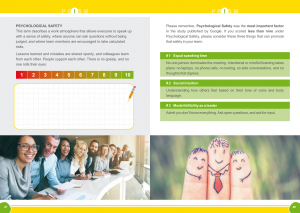That evening Kathleen, Lilly, and Nils arrived about an hour before the meeting to set up the room before the participants arrived. Nils opened the meeting in Swedish, explaining that they had an American guest, helping to transition the group into English.
Nils stepped up to the flipchart and drew a large “R” on the paper. Turning to the group, he said, “R stands for Relationships. Leadership excellence means building and fostering healthy relationships with employees and coworkers.” He paused a moment to let the words register and then added, “It also means helping to foster healthy relationships between employees.”
A young man in the group spoke up and asked, “We have to make them like each other?”
Nils smiled and answered, “No. Leadership excellence means taking responsibility for creating a climate where people enjoy coming to work. They feel safe not only in expressing their opinions, but also know that their opinions are appreciated and valued by you and their colleagues. There is a climate where no negative gossiping or online chats about another person takes place. It’s a climate where issues are not swept under the carpet, but rather addressed openly, respectfully, and timely. From Monday to Friday, teams spend more time together than with their own families. The workplace can be seen as an extended family. If people work day in and day out in a toxic environment – gossiping, lack of trust, hurting each other – they will not perform at their best.”
Kathleen thought about the type of climate that her team had. Was it a safe environment where people spoke up and felt appreciated? She somehow doubted it and then jotted down a few thoughts in her journal as Nils asked the group, “What happens when people don’t perform at their best?”
Participants in the room spoke up and said:
“They call in sick.”
“Or just don’t show up.”
“Or burn out and are gone for months.”
“In the meantime, other colleagues have to fill in for their sick coworkers while still getting their own jobs done, and then they are exhausted or frustrated or bitter. As a result, they get sick from work overload.”
“Or all of the above.”
“They stop contributing at meetings. They just sit there passively, not saying a word. It’s like a wave of apathy has rolled over them. They look out the window and daydream or play with their phones.”
“Innovation drops, because there are no new ideas. There is no motivation to speak up and contribute new ideas if you’re not in an environment where you feel safe and appreciated.”
“Productivity and quality drop. They are too busy fighting with each other or finger-pointing when mistakes are made.”
“Right – no ownership for mistakes and no learning from them.”
“And other people wind up making the same mistakes.”
“Then, you wind up with even bigger losses in productivity and quality.”
“There are no heated, passionate debates. No one cares anymore. It’s the classic ‘work-to-rule syndrome’. Everyone does exactly what they are supposed to do, but not one bit more. There is no thinking outside the box, no motivation to go the extra mile and a general sense of apathy.”
“People run to the boss to fix their problems, and the boss ends up like a group leader in kindergarten, solving interpersonal conflicts all day instead of doing what he or she should be doing.”
“And what should he or she be doing?” Nils asked, throwing the question into the round.
“Developing people,” replied a young woman in the back of the room.
“Right!” Nils agreed and reiterated, “developing people.”
“But that’s not his or her only job, is it?” Kathleen asked.
“No, but it’s one of their main jobs,” Nils countered. He then dug around in his satchel and pulled out five cards, waving them in the air.














